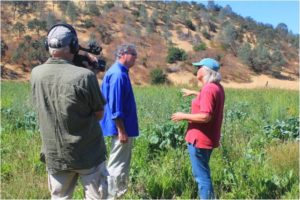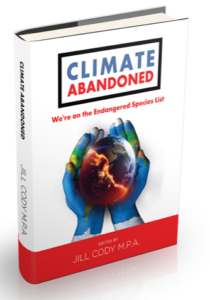Resources for Climate Change Reversal
What will you do to help reverse climate change?
Top Ten Actions to take
Start here: 1. Watch The Dirt on Climate Change (Vimeo link, released 18 April 2018), a film by Lois Robin, Producer, Ed Schehl, videographer and editor, and Jon Kennedy, host.
Featuring: 
- Morris Grassfed, Joe Morris, Rancher, owner
- Paicines Ranch, Sally Calhoun, regenerative agriculture educator, rancher & farmer
- How do old growth trees and groundwater tie in? Watch and see.
Second, watch this Roundtable Panel Discussion (~90 minutes), and pick your own actions. more
Recorded in Santa Cruz on 12 August 2018 entitled “What can we do about carbon?”
Includes extensive Q&A (stay tuned for edited version and curriculum).
Third, learn more: connect with those affiliated with the Dirt filmmakers:
- Kiss the Ground (award-winning movie, more at kissthegroundmovie.com)
- Biodiversity for a Livable Climate
- Verna Jigour PhD, consulting conservation ecologist [bio]
- Daniel Robin, specializing in renewables project development & finance, plus a 21-minute Harvard University presentation on this topic and March 2021 article:
Climate Stabilization through a Bio-Inspired Approach
Soil-Carbon-related Media Resources — holistic or multi-paddock grazing, water cycles, eco-restoration and biodiversity
Why Grass-fed Meats? Buying local and organic food minimizes emissions from transportation and keeps soil and air free from toxins, but regenerative ag (practices like multi-paddock or “holistic” grazing management) builds up topsoils and, in the process, captures and sequesters massive amounts of soil carbon, increases biodiversity and rehydrates the land. This is the “biological” approach the film describes.
- Read the new book Climate Abandoned: We’re on the Endangered Species List, released April 2019, by Jill Cody. Lois Robin wrote the chapter on eco-restoration, entitled The Dirt on Climate Change™.
- Recent NY Times article on how “agriculture could pull carbon out of the air and into the soil — but it would mean a whole new way of thinking about how to tend the land.”

- Tony Lovell, “Soil Carbon: Putting Carbon Back Where It Belongs,” TEDx Talk, Dubbo, New South Wales, Australia, 2011.
- Savory Institute 3-1/2 min. animated intro, Holistic Planned Grazing
- Peter Byck, Soil Carbon Cowboys, a wonderful 12-minute video interviewing three farmers who discovered the profound difference that holistic planned grazing makes for their land, their lives, and the health of the planet.
- Video: Holistic Management at Work, just over 6 minutes, where ranchers describe the success they’ve had revitalizing their land using Holistic Management practices.
- Allan Savory’s milestone 2013 TED Talk, How to fight desertification and reverse climate change, addresses the “Perfect Storm” of the current global climate crisis by promoting a solution to the complex and widespread desertification problem: holistic land management and planned grazing. Using examples of soil regeneration in areas such as Zimbabwe and Patagonia, Savory illustrates how planned livestock grazing can profoundly restore barren desertified land to a lush, healthy grassland. Restoring grasslands in desertified areas across the earth has enormous potential to sequester atmospheric greenhouse gases and can play a major role in reversing the climate change trends.
(More resources on holistic land management and planned grazing below)
Soil Health and Organic/Sustainable Agriculture:
- No-Till Farming article from Mother Earth News
- Writing of Kristin Ohlson here or Amazon
- Sponsored by the Center for Food Safety — Why Should Chefs Care About Soil?, Michael Pollan presents an introduction to the power of soils in addressing climate change via this 4-minute video. Conservative in its estimates, but raises important questions in easily understood language.
- Graeme Sait at 20-minute TEDx talk, Noosa, Australia: Humus – the essential ingredient
Focus Topics:
- Drawdown, edited by Paul Hawken, evaluated 100 overlapping solutions and 80 made the cut. See Drawdown Solutions for the ranking, based on the each individual solution’s potential for sequestering gigatons of carbon at reasonable economic costs. A valid analysis that will provide a nuanced understanding of the various pathways, though it missed two important considerations:
- Holistic, systemic approaches are more aligned with nature. There is no single solution that will (or should) sequester gigatons of carbon. The IPCC 2019 report will likely bear that out. Expect multiple interconnected and interdependent pathways to climate change reversal, with the benefits of natural systems — greater stability, replicability and scale.
- How we invest our financial capital matter (3/23/18 Greenbiz article), a lot. This critically important facet got left out. See also A Path to Climate Change Reversal — recent presentation at Harvard University with practical examples and success stories that show how conservation, carbon sequestration, and soil restoration go hand-in-hand with profitable business models.
- BioDiversity for a Livable Climate (Bio4Climate) “best of” summaries: 4-pg Factsheet 2017 | 2-pg version
- Congressional hearing, June 25, 2014, by the Subcommittee on Public Lands and Environmental Regulation, Increasing Soil Carbon on Public Lands (testimony actually starts at 30:07), featuring Biodiversity for a Livable Climate paper, Restoring Carbon Dioxide to Pre-Industrial Levels: Re-Establishing the Evolutionary Grassland-Grazer Relationship, are mentioned by name.
- Written testimony is also available: Ms. Tommie Martin, Supervisor, Gila County, AZ; Mr. Steven H. Rich, Salt Lake City, UT; Dr. Richard Teague, Texas AgriLife Research, Vernon, TX; Mr. John Wick, Co-Founder, Marin Carbon Project, Palo Alto, CA.
Local Action Steps — protecting our old growth forests, citizen activism, buying local, invest/divest:
What else can you do to eliminate waste and avoid causing CO2 emissions? What about …
- Citizens Climate Lobby (CCL chapters all over the world); join Santa Cruz chapter
- Carbon Allowance (SC chapter of CCL is working on a carbon “fee & dividend”) – article on California, Quebec and Ontario’s new alliance | Regional Greenhouse Gas Initiative (RGGI) in other states | Carbon tax equities & more
- Elders Climate Action
- Supporting no-till agriculture (more)
- Buy local (example: Think Local First (Santa Cruz County): tlfsc.org
- Rainwater catchment? Design buildings, yards and urban areas for energy and water efficiency, to catch and use rainwater rather than treating it as an unwanted resource we need to get rid of.
- Protect and enjoy local old-growth forests:
- Volunteer as Santa Cruz County’s Old Growth Forest Network Coordinator. The filmmaker’s son, Daniel Robin, is holding this slot for someone to step in, specifically for Big Basin and Henry Cowell Redwoods. To learn more, contact Daniel
- Support local artists that paint, protect, and preserve parklands via PaintTheParks.com. Art sales benefit the parks system.
- Put Meaning in your Money through Impact Investing: Invest your values … make decisions to have direct positive impacts, and/or divest from the bad actors.
- How does this work? Each time you invest time, energy or financial capital, consider what you are supporting. So-called “impact investing” aligns purpose and values with financial returns. Solar, wind power, energy efficiency, waste-to-value … all make money and offset carbon emissions.
- What’s hot right now (besides the planet)? One win-win-win area is sustainable real estate development (using Real Estate Investment Trusts or REITs), where ecorestoration yields double-bottom-line benefits: healthy soils sequester carbon while improving land values. More at in3finance.com/impact
Got other resources? Let’s expand this list! Email to daniel@daniel-robin.com
Multi-paddock Grazing , Holistic Land Management and Regenerative Agriculture — continued
- Seth Itzkan’s 2012 TEDx talk, Reversing global warming with livestock? Sharing his experiences at the Africa Center for Holistic Management in Zimbabwe, planned grazing educator Seth Itzkan describes the central role of animal grazing as a part of a healthy grassland ecosystem. By mimicking the patterns of mobile wild herds with livestock, we can – and already have – restored grasslands in desertified areas around the globe, allowing the land to store more carbon and water. By revitalizing the health of the water-carbon cycle with planned grazing, we can mitigate warming trends in some of the most vulnerable areas of the globe.
- Chihuahuan Desert Grasslands of Mexico, an inspiring video by the Rocky Mountain Bird Observatory, which collaborates with private landowners to support working ranches to restore and improve grassland habitat for both livestock and birds and other wildlife.
- Greg Judy, “The Healing Effects of Holistic High Density Grazing on Land, Livestock & People’s Lives” 12th Annual Virginia Biological Farming Conference, 2011
- Dan Dagget, The Right Way to be Green, a five-minute silent slideshow with text and stunning before and after photographs of “rested” and damaged bare land, returned to life using Holistic Planned Grazing.
